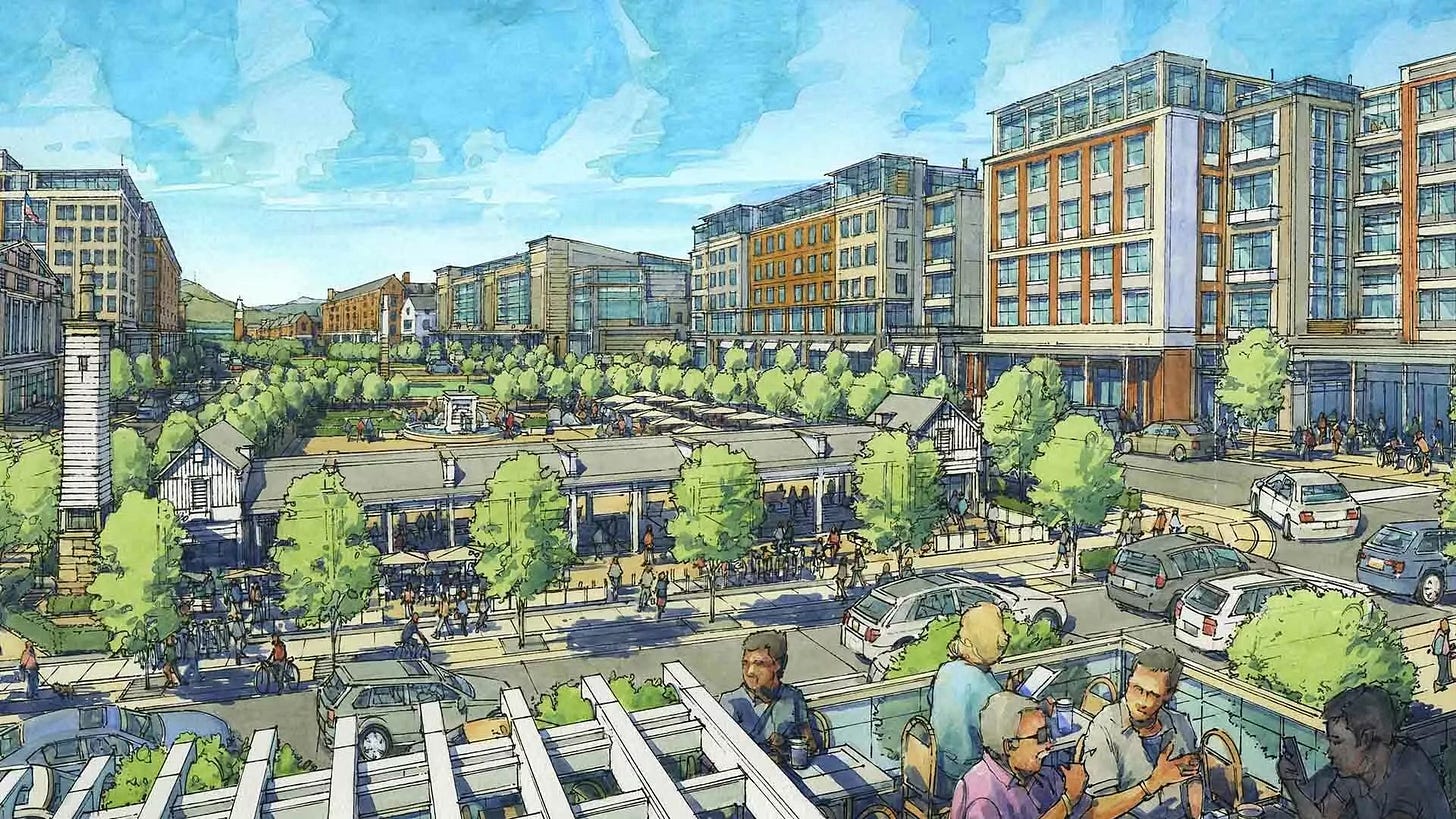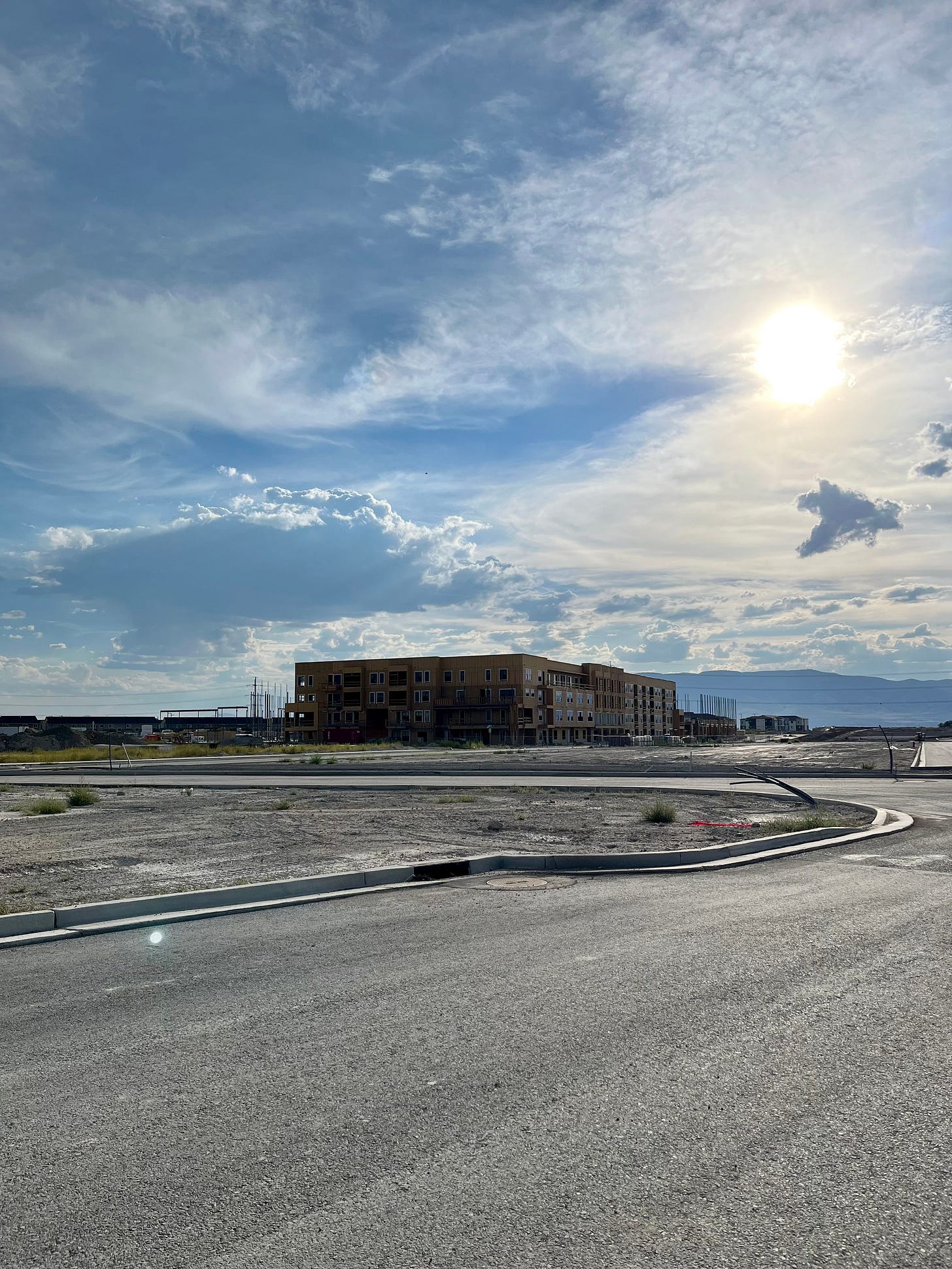A Metropolis on the Shores of Utah Lake
Can a cutting-edge neighborhood in Vineyard help make Utah less car-dependent?
Urban planners, designers, and architects have come together to create a one-of-a-kind patch of Utah called Utah City. The project, headed up by city planner and walkability expert Jeff Speck, is meant to be a sustainable and walkable urban center in Vineyard, Utah. Speck plans to create this space for a diverse community with housing, amenities, recreation and necessities of life all within walking distance.
The development seems to check all the boxes to be a self-sustaining, walkable community, but I’ll just name a few here:
Lakefront property beside Utah Lake
Easy access to a FrontRunner station, Utah’s commuter rail system
Narrow roads with street parking to create easily walkable or bikeable areas
A cancer research center run by the Huntsman Cancer Institute
Close proximity to restaurants, entertainment, and a grocery store called Bella’s Marketplace
Plans for various housing options and hotels
Walkable, sustainable developments like Utah City are products of a movement in urban planning known as New Urbanism. The Congress for the New Urbanism (CNU) defines New Urbanism this way: “a planning and development approach based on the principles of how cities and towns had been built for the last several centuries: walkable blocks and streets, housing and shopping in close proximity, and accessible public spaces. In other words: New Urbanism focuses on human-scaled urban design.”
I interviewed two professors at Brigham Young University on the topic of Utah City, both of whom expressed excitement at the idea of a New Urbanist site in Utah and at Jeff Speck choosing to lead the project. Both professors encouraged Utah Monthly readers to dive deeper by reading Speck’s seminal book Walkable City: How Downtown Can Save America, One Step at a Time.
Laura Redford, an urban historian and an assistant visiting professor at BYU, said there are many benefits to higher-density developments like Utah City, such as preserving land outside the high-density development and reducing car emissions. She also mentioned that communities and economies can benefit from these developments. “We know from Jeff Speck’s book and lots of other research that communities are healthier, they’re more vibrant, people feel more connected when the places that they live feel more walkable. There’s some evidence as well that they’re also economically prosperous.”
However, both professors had concerns about the future of Utah City, as it seems to be a foreign transplant in the middle of a car-centric state and country. Jamin Rowan, a professor in BYU’s English Department who specializes in urban literature, saw the promotional video for Utah City and found himself questioning who the city is really built for.
“Jane Jacobs—one of the twentieth century's great minds and, in some ways, the godmother of New Urbanism—says that ‘new ideas must use old buildings’ because those wanting to try out new ideas often can't afford the rent that new buildings so often demand,” Rowan said. “I worry about how a city like Utah City will evolve as some of the developers’ initial ideas and intended uses turn out to be not what the community needs.”
Although the notion of a walkable city seems appealing, will the project create the tight-knit, diverse community that it says it will? This is a particularly fascinating question in the homeland of the Church of Jesus Christ of Latter-day Saints. Many Utahns know that Joseph Smith was greatly responsible for the grid system of Utah’s streets, which was part of his plan for a community he called Zion.
Joseph Smith’s plan for Utah settlements was called the Zion Plat, a tight-knit grid community where farmers would live inside the city with their families and keep stables, barns, and farmland outside the city. As LDS church membership grew, satellite communities would continue building grids for their farms and settlements with a greenbelt between each old and new community.
Craig Galli, author of an article on Joseph Smith’s foray into urban planning, notes that in 1996, the American Institute of Certified Planners awarded the City of Zion Plat the National Planning Landmark Award, citing the plan as “one of the earliest examples of smart growth.”
Galli lists the specific expectations Joseph Smith had for the community of Zion. Many of these requirements are surprisingly similar to the values and amenities of Utah City:
Equitable land use and environmental stewardship
Education and cultural pursuits
Civic unity and involvement
Diversity and tolerance
Caring for the needy
But where did the Zion Plat go wrong? Why is modern-day Utah built around I-15 and not around walkable, high-density communities in grid shapes?
Dr. Redford credits the U.S. Federal-Aid Highway program for Americans’ attachment to cars and lack of walkable neighborhoods. Construction began on I-15 and I-80 in 1956 as a way to increase mobility throughout the state of Utah. Galli said that initially, urban planners proposed a 2,000-foot-wide greenbelt to run along the highway, but real estate speculators quickly bought property along the interstate, believing (correctly) that proximity to a major thoroughfare would be attractive to prospective buyers. Nowadays, I’d venture to claim that living in Utah without at least one car per household is inconvenient at best and impossible at worst.
I’ll admit that as an American who grew up with the expectation of getting a drivers’ license as soon as possible, my first inclination is to resist a movement away from a society centered around cars. That is until I think about the potential community that could easily be built in a culture that’s centered around walkability and public transportation. Even as a tourist in other countries, I can see how walkable cities and easier access to public transportation make a difference in communities and cultures.
I also grew up LDS and have pioneer ancestry, so the sacrifice the early Saints made to create a robust and tight-knit community is not lost on me. Members of the LDS church believe that God chose Utah as the starting place for the restored church. A community of fellow disciples was important enough to the pioneers that they left their houses and possessions to start their lives over in Utah. Perhaps Utah City is an attempt to recreate that feeling of bonding together in a promised land.
Jeff Speck himself saw something not altogether different in Utah. As he put it in the Utah City promotional video, “I’ve been coming to Utah for many years. When you arrive in the Valley, you realize immediately why the wagon trains stopped. There’s something really spiritual about that place.” While Utah City may seem like a radical proposition to modern Americans, it could be the first step toward becoming a tight-knit Zion community once again.
Also in the news:
On Tuesday, the New York Times quoted BYU ecologist Ben Abbott in an article on “a pattern of questionable contracts [Utah] has awarded over the last decade to politically connected people pushing moneymaking projects they claimed had ecological benefits.” Abbott described one of those projects, a method of controlled deforestation performed by a cable suspended between two bulldozers, as “nothing more than a pet project with a thin veneer of science.” Read the full article here, and read our December 2023 interview with Abbot here.
On September 6, Chris Stevenson co-authored a piece for the Deseret News on the approaching presidential election, arguing that “no matter the political normalcy his campaign attempts to convey, a vote for Donald Trump is, by definition, a vote to weaken free and democratic government.” Read the full op-ed here, and read our March 2024 interview with Chris here.
On September 5, Utah Monthly contributing writer Emily Richael penned a reflection on backlash to Hulu’s new series The Secret Lives of Mormon Wives for the Salt Lake Tribune. Read her commentary here, and her most recent Utah Monthly post here.







This is a fantastic article - urban planning's role in Christ's latter-day Zion. My son Adam, who is an urban planner, and I, who grew up in one of the early Levittowns on the east coast, talked at great length about this on a trip to Pittsburgh. It seems that how communities are put together has much to do with the spiritual health of the people who live there. I hope the Utah Monthly does more on this subject.